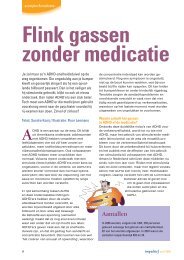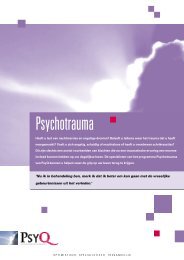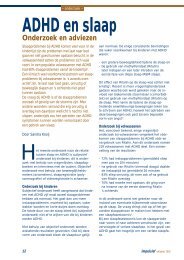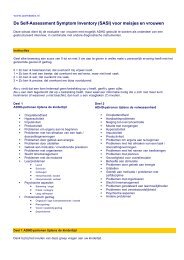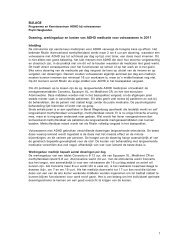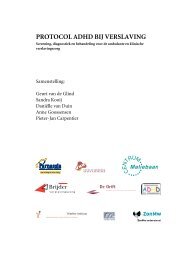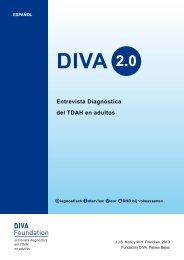Diagnostic Interview for ADHD in adults (DIVA) - PsyQ
Diagnostic Interview for ADHD in adults (DIVA) - PsyQ
Diagnostic Interview for ADHD in adults (DIVA) - PsyQ
You also want an ePaper? Increase the reach of your titles
YUMPU automatically turns print PDFs into web optimized ePapers that Google loves.
Instructions <strong>for</strong> per<strong>for</strong>m<strong>in</strong>g the <strong>DIVA</strong><br />
The <strong>DIVA</strong> is divided <strong>in</strong>to three parts that are each applied<br />
to both childhood and adulthood:<br />
(1) The criteria <strong>for</strong> Attention Deficit (A1)<br />
(2) The criteria <strong>for</strong> Hyperactivity-Impulsivity (A2)<br />
(3) The Age of Onset and Impairment accounted <strong>for</strong> by<br />
<strong>ADHD</strong> symptoms<br />
Start with the first set of DSM-IV criteria <strong>for</strong> attention deficit<br />
(A1), followed by the second set of criteria <strong>for</strong> hyperactivity/impulsivity<br />
(A2). Ask about each of the 18 criteria <strong>in</strong><br />
turn. For each item take the follow<strong>in</strong>g approach:<br />
First ask about adulthood (symptoms present <strong>in</strong> the last<br />
6-months or more) and then ask about the same symptom<br />
<strong>in</strong> childhood (symptoms between the ages of 5 to 12<br />
years) 4-6 . Read each question fully and ask the person<br />
be<strong>in</strong>g <strong>in</strong>terviewed whether they recognise this problem<br />
and to provide examples. Patients will often give the same<br />
examples as those provided <strong>in</strong> the <strong>DIVA</strong>, which can then<br />
be ticked off as present. If they do not recognise the<br />
symptoms or you are not sure if their response is specific<br />
to the item <strong>in</strong> question, then use the examples, ask<strong>in</strong>g<br />
about each example <strong>in</strong> turn. For a problem behaviour or<br />
symptom to be scored as present, the problem should<br />
occur more frequently or at a more severe level than is<br />
usual <strong>in</strong> an age and IQ matched peer group, or to be<br />
closely associated with impairments. Tick off each of the<br />
examples that are described by the patient. If alternative<br />
examples that fit the criteria are given, make a note of<br />
these under “other”. To score an item as present it is not<br />
necessary to score all the examples as present, rather the<br />
aim is <strong>for</strong> the <strong>in</strong>vestigator to obta<strong>in</strong> a clear picture of the<br />
presence or absence of each criterion.<br />
For each criterion, ask whether the partner or family<br />
member agrees with this or can give further examples of<br />
problems that relate to each item. As a rule, the partner<br />
would report on adulthood and the family member (usually<br />
parent or older relative) on childhood. The cl<strong>in</strong>ician has to<br />
use cl<strong>in</strong>ical judgement <strong>in</strong> order to determ<strong>in</strong>e the most<br />
accurate answer. If the answers conflict with one another,<br />
the rule of thumb is that the patient is usually the best<br />
<strong>in</strong><strong>for</strong>mant 7 .<br />
The <strong>in</strong><strong>for</strong>mation received from the partner and family is<br />
ma<strong>in</strong>ly <strong>in</strong>tended to supplement the <strong>in</strong><strong>for</strong>mation obta<strong>in</strong>ed<br />
from the patient and to obta<strong>in</strong> an accurate account of both<br />
current and childhood behaviour; the <strong>in</strong><strong>for</strong>mant <strong>in</strong><strong>for</strong>mation<br />
is particularly useful <strong>for</strong> childhood s<strong>in</strong>ce many patients<br />
have difficulty recall<strong>in</strong>g their own behaviour retrospectively.<br />
Many people have a good recall <strong>for</strong> behaviour from<br />
<strong>DIVA</strong> 2.0 <strong>Diagnostic</strong> <strong>Interview</strong> <strong>for</strong> <strong>ADHD</strong> <strong>in</strong> <strong>adults</strong><br />
around the age of 10-12 years of age, but have difficulty<br />
<strong>for</strong> the pre-school years.<br />
For each criterion, the researcher should make a decision<br />
about the presence or absence <strong>in</strong> both stages of life,<br />
tak<strong>in</strong>g <strong>in</strong>to account the <strong>in</strong><strong>for</strong>mation from all the parties<br />
<strong>in</strong>volved. If collateral <strong>in</strong><strong>for</strong>mation cannot be obta<strong>in</strong>ed, the<br />
diagnosis should be based on the patient’s recall alone. If<br />
school reports are available, these can help to give an<br />
idea of the symptoms that were noticed <strong>in</strong> the classroom<br />
dur<strong>in</strong>g childhood and can be used to support the diagnosis.<br />
Symptoms are considered to be cl<strong>in</strong>ically relevant if<br />
they occurred to a more severe degree and/or more<br />
frequently than <strong>in</strong> the peer group or if they were impair<strong>in</strong>g<br />
to the <strong>in</strong>dividual.<br />
Age of onset and impairment<br />
The third section on Age of Onset and Impairment accounted<br />
<strong>for</strong> by the symptoms is an essential part of the<br />
diagnostic criteria. F<strong>in</strong>d out whether the patient has always<br />
had the symptoms and, if so, whether any symptoms were<br />
present be<strong>for</strong>e 7-years of age. If the symptoms did not<br />
commence till later <strong>in</strong> life, record the age of onset.<br />
Then ask about the examples <strong>for</strong> the different situations <strong>in</strong><br />
which impairment can occur, first <strong>in</strong> adulthood then <strong>in</strong><br />
childhood. Place a tick next to the examples that the<br />
patient recognises and <strong>in</strong>dicate whether the impairment is<br />
reported <strong>for</strong> two or more doma<strong>in</strong>s of function<strong>in</strong>g. For the<br />
disorder to be present, it should cause impairment <strong>in</strong> at<br />
least two situations, such as work and education; relationships<br />
and family life; social contacts; free time and<br />
hobbies; self-confidence and self-image, and be at least<br />
moderately impair<strong>in</strong>g.<br />
Summary of symptoms<br />
In the Summary of Symptoms of Attention Deficit (A) and<br />
Hyperactivity-Impulsivity (HI), <strong>in</strong>dicate which of the<br />
18 symptom criteria are present <strong>in</strong> both stages of life; and<br />
sum the number of criteria <strong>for</strong> <strong>in</strong>attention and hyperactivity/<br />
impulsivity separately.<br />
F<strong>in</strong>ally, <strong>in</strong>dicate on the Score Form whether six or more<br />
criteria are scored <strong>for</strong> each of the symptom doma<strong>in</strong>s of<br />
Attention Deficit (A) and Hyperactivity-Impulsivity (HI). For<br />
each doma<strong>in</strong>, <strong>in</strong>dicate whether there was evidence of a<br />
lifelong persistent course <strong>for</strong> the symptoms, whether the<br />
symptoms were associated with impairment, whether<br />
impairment occurred <strong>in</strong> at least two situations, and<br />
whether the symptoms might be better expla<strong>in</strong>ed by<br />
another psychiatric disorder. Indicate the degree to which<br />
3



